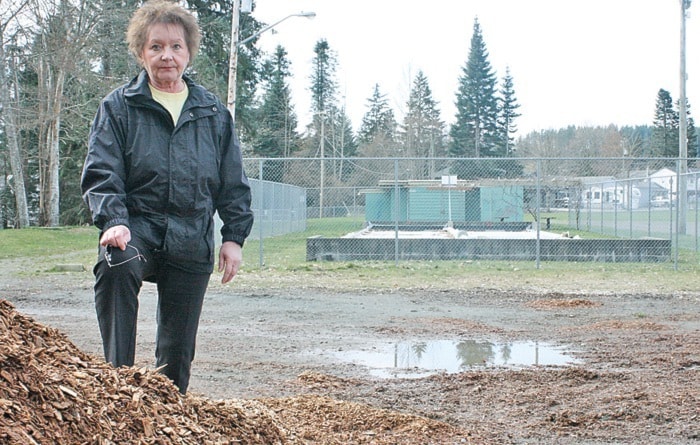A Campbell River woman, concerned about the potential health effects of a proposed cell phone tower in Willow Point Park, is knocking on doors warning nearby residents.
Nan Latchford is trying to raise awareness and is circulating a petition to stop Telus’ plans for a 30-metre high tower in the park near the bocce ball court, in an area where cedar chips are piled up.
Latchford said her main concern is the radiation that people, particularly children playing in the park, could be exposed to.
“It’s an increase in pollution – in electromagnetic frequency (EMF) and radio frequency (RF) pollution. We are adding more and more to our environment and it has an accumulative effect,” Latchford said. “The worst in my mind is that you don’t see it, you can’t smell it, you can’t touch it but there’s nowhere to hide. There is no proof that there are safe levels of exposure to EMF and RF for people (and) children are effected at lower exposure rates.”
Latchford, who has read several studies into the effects of radiation, said because children are especially vulnerable she can’t believe Telus wants to put the tower in Willow Point Park.
“It’s closely surrounded by residences and it’s in a park where children play, where the baseball diamond is, where the bocce court is and the closer people are to the tower, the more effect these frequencies will have,” she said.
Telus, which is proposing to install the tower to improve spotty cell phone coverage in the Willow Point area, is following Industry Canada guidelines. Industry Canada follows Health Canada’s Safety Code 6, which limits radio frequency exposure.
According to Health Canada, in 2011 the “International Agency for Research on Cancer (IARC) classified RF energy as ‘possibly carcinogenic to humans’. The IARC classification reflects the fact that some limited evidence exists that RF energy might be a risk factor for cancer. However, the vast majority of scientific research to date does not support a link between RF energy exposure and human cancers. At present, the evidence of a possible link between RF energy exposure and cancer risk is far from conclusive and more research is needed to clarify this possible link. With respect to cell phone towers, as long as exposures respect the limits set in Health Canada’s guidelines, there is no scientific reason to consider cell phone towers dangerous to the public.”
But a 2012 BioInitiative report, written by 14 scientists, public health and public policy experts, says “the effects of long-term exposure to wireless technologies...and from whole-body exposure to RF transmissions from cell towers and antennas is simply not yet known with certainty. However, the body of evidence at hand suggests that bioeffects and health impacts can and do occur at exquisitely low exposure levels.”
Latchford, who lives less than a five minute drive away from the park, said it’s a risk she doesn’t want to take and she’s encouraging everyone to educate themselves.
She has set up a community profile for the proposed Willow Point tower on the website, www.c4st.org which provides an easy way for public input which is then directed to Telus and city council. The community profile is listed under Cell Phone Tower disputes. Latchford has also set up an e-mail address, willowpointpark@yahoo.ca for people to get their name put onto the petition.
Telus will be collecting public feedback until April 12.
